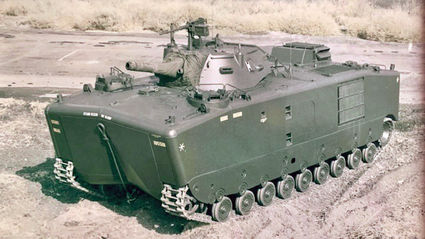The Stradivarius
The Spirit of Tehachapi
July 22, 2023
People tell me that they like to hear some of my husband’s old Marine Corps tales. I always enjoyed this one. My husband’s MOS (Military Occupational Specialty) was LVTs. Those letters stand for Landing Vehicle Tracked. I always wondered why they didn’t term it Tracked Landing Vehicle but ours is not to correct Uncle Sam in the naming of his machines of war. There are several models of the 30 ton monsters. This story refers to the LVTH-6 and LVTP-5. It is interesting how the word “Stradivarius” could possibly work itself into a story about a 30-plus ton amphibious vehicle.
(Definition: Stradivarius, one of the famous violins produced by the fine workmanship of Antonio Stradivarius 1644-1737.)
The Stradivarius
by CWO-4 Doyle D. Gracey, USMC Ret.
In June of 1966, I returned from a tour of duty in Vietnam and received orders for Independent Duty as the Marine Corps Liaison Officer at Food Machinery Corporation (FMC), a very large company in San Jose, Calif. The purpose was to totally rebuild several hundred LVTP-5s and a like number of LVTH-6s. This was a period in time when we were engaged in a hopeless struggle in Vietnam and there were no new machines of war built. This made it necessary to revamp and rebuild our existing amphibians and make them “war worthy.” FMC was the perfect location for this endeavor for the machines could be shipped directly by rail.
I was fortunate to have a Gunnery Sergeant from Philadelphia, a Sgt. Ken Harris, who was well-schooled in supply matters, record keeping and correspondence. A good man with which to work.
A third Marine in our trio detail, was Staff Sergeant Stafford. He was a top notch man who thoroughly understood the mechanics of the vehicles.
We were not awed by the big corporation, the personnel or the assets. We settled for nothing less than a dollars worth of goods or services for the money we controlled. When they found out our demands, we embarked on a mutual agreement to accomplish our task.
Looking back, it was truly an interesting situation; we had an adequate office staff and access to all FMC personnel to accomplish our tasks, but we answered solely to Headquarters Marine Corps. “Gunny” Harris kept very accurate records and Staff Sergeant Stafford kept me right up to the minute on things he liked and disliked in the shops.
Our three man crew controlled several million dollars of tax payer money over a period of three years and we were able to turn out an excellent product. FMC had a test track used to shake these vehicles down once they were completed. One afternoon as I rolled to a stop after testing one of our first H-6s, a Mr. Childers, one of FMCs top notch welders, stepped up to me and said, “You’re trying to destroy that thing, aren’t you?”
“What gives you that idea?” I asked him.
“Well, “ he said. “Sliding sideways through the turns at full throttle and getting it airborne over the humps for one thing. You want it to fly? Why are you so hard on that H-6?” he said.
Then a Mr. Hernandez, another excellent welder, stepped up to join us and said, “It’s a good thing that machine doesn’t have wings or it’d be over Toledo by now!”
I hastened to explain to them that I had subjected the amphibian to no more stress than it would receive at the hands of fighting men of the Corps. Sgt. Stafford chimed in and explained and that we have an obligation to the men operating the vehicle to see that it’s in the best condition possible. He also said that most likely we would end up in one someday ourselves.
Stafford was so proud of the job we were doing on the vehicles that he wished he could put some sort of logo on the machine to indicate its quality and where it had been built. We decided to use the name Stradivarius, to indicate fine workmanship, and we made a stencil using Old English lettering. We stenciled it on the starboard bulkhead, just inside the bow; on each vehicle.
On my next tour to Vietnam in 1969 I was to see many of these “Stradivarius” machines. I was happy to note that even though the vehicle might have been painted, they had not painted over the name.
I mentioned the fact to one of my crew chiefs and asked why they’d left the name visible. He said, “Well, after I finally found out what in the hell a Stradivarious was, I thought I’d write the folks back home and tell them just what kind of music me and my crew could make with the 105 Howitzer mounted on it.”





